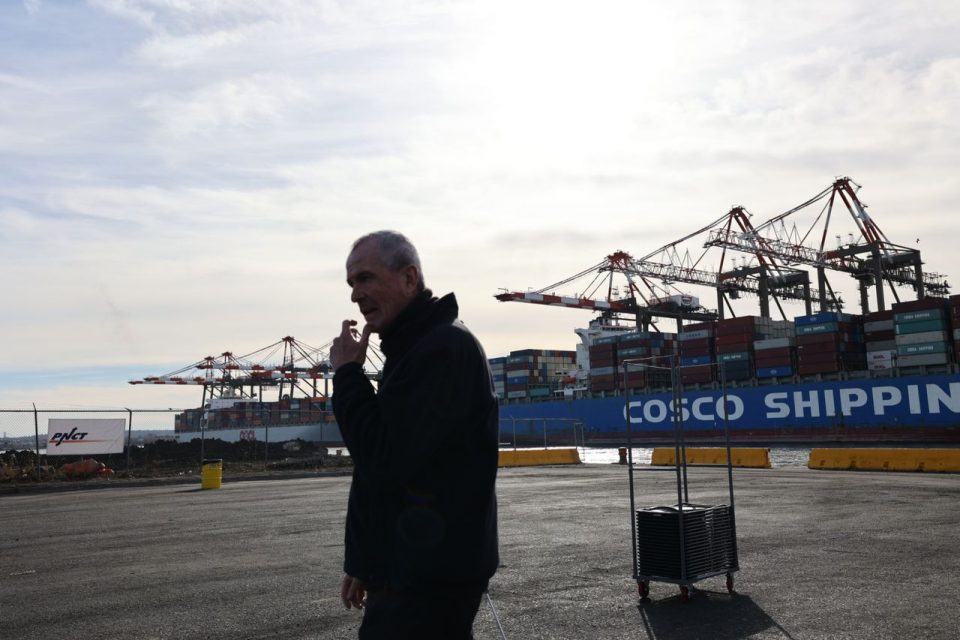The worldwide supply chain disruptions that snarled Christmas deliveries around the globe seemed far away Friday from the hulking gantry cranes hovering over the black hull of the CCNI Andes, a huge container ship taking on cargo in New Jersey.
Unlike the Port of Los Angeles — the nation’s busiest, and ground zero for the crisis that has seen as many as 100 ships waiting at anchor to be berthed and unloaded — the operations at Port Newark in New Jersey seemed barely affected by the problems elsewhere.
The crisis has led to critical shortages of computer chips and electronics gear, toys and all kinds of imported goods, amid backed up ship traffic in many U.S. ports.
But on Friday morning, there were only five ships at anchor outside New York Harbor. And several ships were docked and being loaded, including the CCNI Andes, recently arrived by way of Egypt.
Gov. Phil Murphy, in a stop to take note of the port’s ability to weather the troubles seen elsewhere, said the supply chain challenges have been a direct result of the pandemic. But he said the issues causing so much delay on the West Coast have not been mirrored at the East Coast’s largest port.
“New Jersey has avoided the supply chain and logistical breakdowns that much of our country has faced,” he said.
Pointing out that 40% of the nation’s Christmas presents will come through the New York and New Jersey ports, he added: “Santa Claus’s presents are on the way.”
Despite the upbeat message, shipping costs here — as everywhere — are continuing to skyrocket, hurting businesses and hitting consumers especially hard in the pocketbook as the price of goods on store shelves goes up. Rep. Josh Gottheimer, D-5th Dist., has repeatedly raised an alarm about the impact higher shipping costs on businesses and families, and has called for congressional hearings.
According to Gottheimer, the average cost to move a shipping container has gone from $1,000 before the start of the pandemic, to between $22,000 and $30,000 today.
But unlike the situation in California, where lines of ships remain despite measures to cut the congestion, the average weekly wait time at the Port of New York and New Jersey is currently 2.24 days, officials say.
Friday’s event was somewhat of a pat on the back for those who operate the port, bringing together representatives of the shipping industry, the Port Authority of New York and New Jersey, and the International Longshoremen’s Association, whose members load and unload the ships.
Officials credited the port’s ability to continue normal operations — despite the supply chain problems elsewhere — to port workers and the terminals, as well as extensive and costly infrastructure improvements made in recent years.
Those included harbor-deepening efforts, the raising of the Bayonne Bridge that enabled larger cargo ships to call on New York and New Jersey, extending gate hours of operations at marine terminals and expanding the ExpressRail Intermodal Rail System that moves cargo containers in and out of the port.
Murphy said future improvements include the New Jersey Turnpike Authority’s Newark-Bay Hudson County Extension roadway widening and reconstruction project, which will allow for greater capacity of commercial traffic into the port.
Bethann Rooney, the Port Authority’s deputy director who oversees overall port operations, said the investments have meant more of the ultra-large container ships that carry more and more of the global trans-ocean cargo can now be handled at the same time.
In fact, the ports in New York, New Jersey and Staten Island set a new record in October for cargo and is on track to set a new annual record this year. According to Rooney, the port will likely handle 22% more cargo than it did last year.
The lack of significant delays has in fact brought more business.
Officials noted that some ships sitting in port on Friday had skipped planned stops on the West Coast — steaming tens of thousands of additional miles to offload cargo here instead, saving time that would have been spent waiting at anchor. They said according to the global logistics firm Shifl, it is now 25% faster for ships from China to reach the Port of New York and New Jersey than ports on the West Coast.
“This port is literally unique in the nation’s port infrastructure,” said Murphy.
__
Local journalism needs your support. Subscribe at nj.com/supporter.
Ted Sherman may be reached at [email protected]. Follow him on Twitter @TedShermanSL


